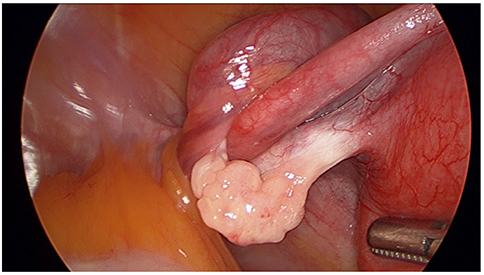Obstet Gynecol Sci.
2017 Jul;60(4):387-390. 10.5468/ogs.2017.60.4.387.
Significant elevation in serum CA 125 and CA 19-9 levels with torsion of the hydrosalpinx in a postmenopausal woman
- Affiliations
-
- 1Department of Obstetrics and Gynecology, CHA Gangnam Medical Center, CHA University, Seoul, Korea.
- 2Department of Obstetrics and Gynecology, CHA Bundang Medical Center, CHA University, Seongnam, Korea. shsong8@gmail.com
- KMID: 2386283
- DOI: http://doi.org/10.5468/ogs.2017.60.4.387
Abstract
- Isolated torsion of the fallopian tube in postmenopausal women is rare. In this case report, we detail the case of a 53-year-old patient who presented with adenomyosis and a left hydrosalpinx with high levels of CA 125 and CA 19-9. The isolated torsion of the left hydrosalpinx was observed during the operation. The serum levels of CA 125 and CA 19-9 were reduced from 129.62 and 348 to 58.2 and 12.41 U/mL, respectively, after total laparoscopic hysterectomy with salpingectomy. On radiologic evaluation, there were no other factors that may have influenced the increase in serum levels of CA 125 and CA 19-9 in this patient, which were reduced after operation. To the best of our knowledge, this is the first case of association between perioperative changes in CA 19-9 levels and isolated torsion of the fallopian tube.
MeSH Terms
Figure
Reference
-
1. Hansen OH. Isolated torsion of the Fallopian tube. Acta Obstet Gynecol Scand. 1970; 49:3–6.2. Toyoshima M, Mori H, Kudo K, Yodogawa Y, Sato K, Kudo T, et al. Isolated torsion of the fallopian tube in a menopausal woman and a pre-pubertal girl: two case reports. J Med Case Rep. 2015; 9:258.3. Phillips K, Fino ME, Kump L, Berkeley A. Chronic isolated fallopian tube torsion. Fertil Steril. 2009; 92:394.e1–394.e3.4. Ozgun MT, Batukan C, Turkyilmaz C, Serin IS. Isolated torsion of fallopian tube in a post-menopausal patient: a case report. Maturitas. 2007; 57:325–327.5. Ding DC, Hsu S, Kao SP. Isolated torsion of the hydrosalpinx in a postmenopausal woman. JSLS. 2007; 11:252–254.6. Feng L, Liu Y, Liu H, Chen X. Chronic isolated fallopian tube torsion associated with huge hydrosalpinx and hemosalpinx in a postmenopausal woman: a case report and brief review. Eur J Obstet Gynecol Reprod Biol. 2012; 164:235–236.7. Youssef AF, Fayad MM, Shafeek MA. Torsion of the fallopian tube. A clinico-pathological study. Acta Obstet Gynecol Scand. 1962; 41:292–309.8. Benjaminov O, Atri M. Sonography of the abnormal fallopian tube. AJR Am J Roentgenol. 2004; 183:737–742.9. Vijayaraghavan SB. Sonographic whirlpool sign in ovarian torsion. J Ultrasound Med. 2004; 23:1643–1649.10. Baumgartel PB, Fleischer AC, Cullinan JA, Bluth RF. Color Doppler sonography of tubal torsion. Ultrasound Obstet Gynecol. 1996; 7:367–370.11. Ghossain MA, Buy JN, Bazot M, Haddad S, Guinet C, Malbec L, et al. CT in adnexal torsion with emphasis on tubal findings: correlation with US. J Comput Assist Tomogr. 1994; 18:619–625.12. Rha SE, Byun JY, Jung SE, Jung JI, Choi BG, Kim BS, et al. CT and MR imaging features of adnexal torsion. Radiographics. 2002; 22:283–294.13. Fujiwara K, Moriya T, Mikami Y, Hiratsuka J, Sawada S, Imajo Y, et al. Significant increases in serum CA125 and CA19-9 following torsion from an adenofibroma of the ovary: a case report. Jpn J Clin Oncol. 1994; 24:116–119.14. Suh DS, Moon SH, Kim SC, Joo JK, Park WY, Kim KH. Significant simultaneous changes in serum CA19-9 and CA125 due to prolonged torsion of mature cystic teratoma of the ovary. World J Surg Oncol. 2014; 12:353.15. Kyung MS, Choi JS, Hong SH, Kim HS. Elevated CA 19-9 levels in mature cystic teratoma of the ovary. Int J Biol Markers. 2009; 24:52–56.
- Full Text Links
- Actions
-
Cited
- CITED
-
- Close
- Share
- Similar articles
-
- An Immunohistochemical Study of CA 125, CA 19-9, and CA 15-3 in Ovarian Epithelial Tumors
- A case of Meigs' syndrome with elevated serum CA 125 level
- The clinical significance of serum CA 125, CA 19-9 and eosinophil levels in endometriosis
- Clinical application of serum CA 125 and CA 19-9 in Endometriosis
- Clinical Significance of Serum CA 125, CA 19-9 as Tumor Markers in Benign Ovarian Tumors


